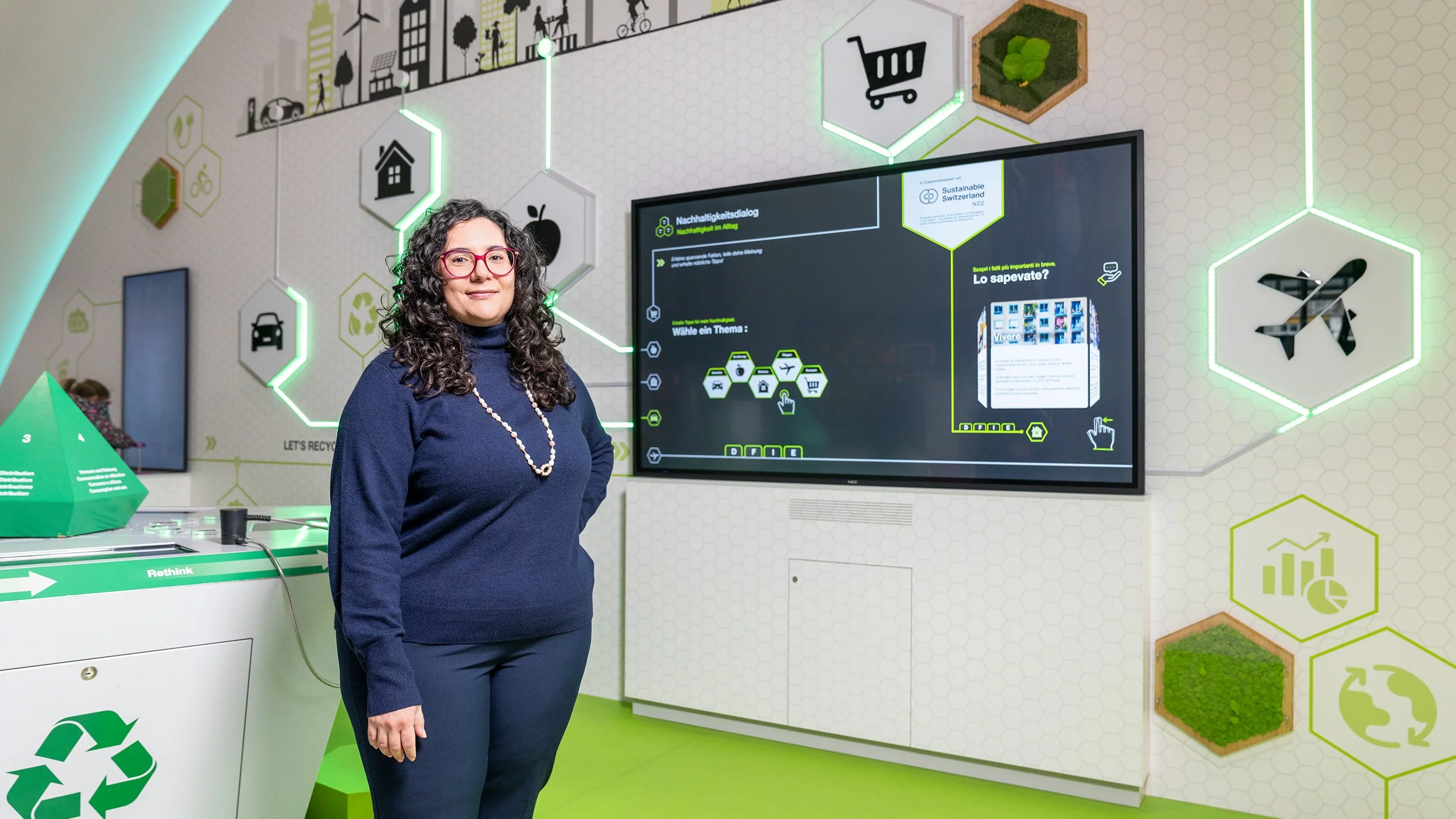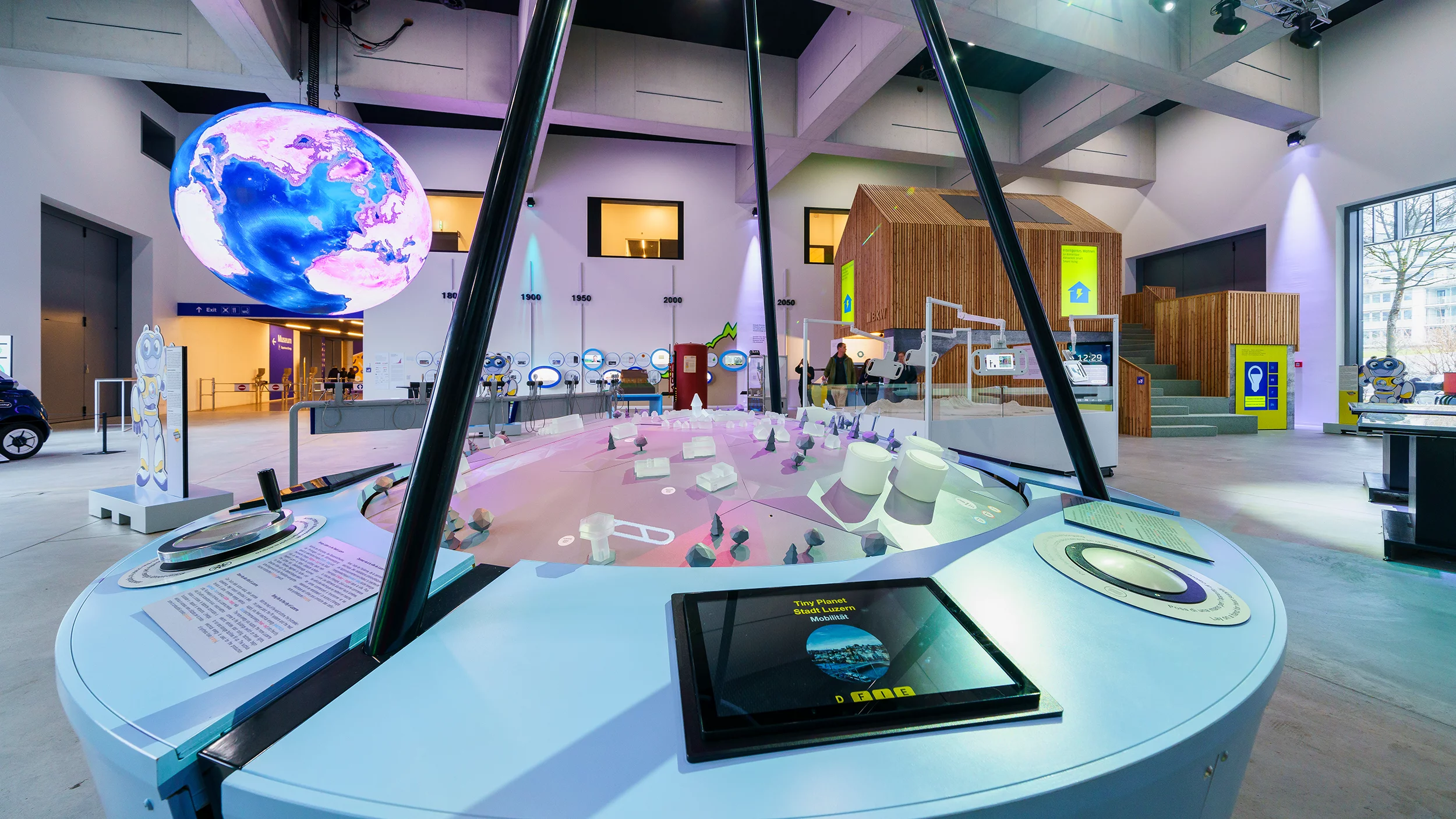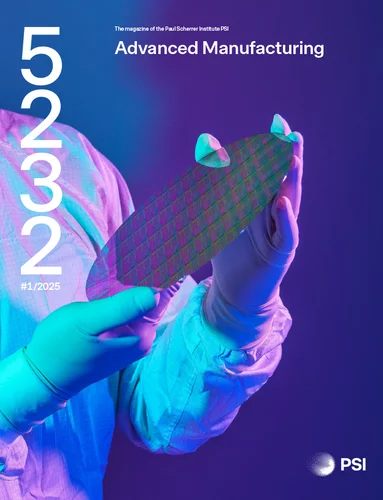Energy Science for Tomorrow (ES4T) is a joint initiative of ETH Zurich, EPFL, EMPA, PSI and the Swiss Museum of Transport. Its aim is to make energy issues understandable and tangible for every generation and thereby promote the dialogue between science, business and society.
The Emission Explorer exhibit confronts visitors to theMuseum of Transport with some very personal questions: What do you eat?” or “How often do you buy new things?” The questions are colourfully presented on an interactive screen with five possible answers: Do I live a ‘vegan’ lifestyle, or do I eat meat ‘like a lion’? Do I ‘almost never’ buy things, or do I ‘love to shop’? The questions call for critical self-assessment and at the same time a certain amount of courage – after all, with the personal answer on the screen, you are also exposing yourself to the next person in line.
Since October 2024, the Emission Explorer has been located in the House of Energy as part of the permanent exhibition at the Museum of Transport, Switzerland’s most-visited museum, with over one million admissions in 2023. The exhibit was financed by the ETH Board, which aims to encourage a dialogue within society as part of the ES4T joint initiative. As its name suggests, the exhibit aims to explore visitors’ emission behaviour and sensitise them to their very personal carbon footprint.
“With five simple questions, we want to show in a playful way how personal behaviour can influence carbon emissions,” explains Alicia Siliézar, part of the team behind the ES4T initiative. An archaeologist by training, she has experience of working in various museums and exhibitions, and alongside her involvement in the ES4T, she also works at the PSI Visitor Center. “In addition to personal emissions, our exhibit also looks at systemic emissions, those to which we contribute indirectly because they arise through the local infrastructure, for example.”
Dialogue platform for energy topics
With the opening the House of Energy in April 2023, the Swiss Museum of Transport not only inaugurated a modern and energy-efficient new building, it also entered new thematic territory with the exhibition it houses. Right alongside the Railway Hall with its collection of historic Swiss trains – a place that probably awakens school trip nostalgia for many a Swiss visitor – the permanent exhibition Experience Energy! now takes visitors on a journey into the sustainable Switzerland of the future.
Various partners from business, education, and research have been involved in the design of the exhibition and thus find a platform for political and social dialogue. In addition to the institutions of the ETH Domain, the Aargau power company Swissgrid and the energy and infrastructure company BKW are also represented – the latter shows, in its exhibit, how intelligent living of the future could reduce energy consumption.
For research such as that carried out at PSI, the ES4T joint initiative offers completely new opportunities: “This platform helps us communicate energy issues to a broad audience – and thus to strengthen people’s understanding of the importance and urgency of restructuring our energy supply: away from fossil fuels and towards renewable energy sources,” explains Christian Bauer, an environmental scientist at PSI’s Laboratory for Energy Systems Analysis. Mirjam van Daalen, Head of Communications at PSI, also points out: “Through this joint initiative, we are bringing the coordinated, concentrated knowledge of our research in the ETH Domain to a family audience.”
At the opening ceremony for the House of Energy, Martin Bütikofer, Director of the Swiss Museum of Transport, explained how the topic of energy fits in with the museum. He was quoted at the time by the paper Luzerner Zeitung as saying, with a twinkle in his eye: “We could have decided to build a new house for old locomotives. There are also countless old bicycles that we don’t yet have. These are great hobbies, but they don’t move us forward as a society. Energy has everything to do with mobility, 100 percent.”
But energy as a form of propulsion is only one aspect of the exhibition. It also highlights current issues such as global warming, climate protection and the future security of energy supplies. For example, a hologram of the Swiss environmental pioneer Bertrand Piccard takes us on an animated journey into a renewable energy system for Switzerland in 2050. A digital globe visualises the connection between people’s energy use and its impact on the climate and the planet.
The art of communication
But how can complex scientific topics be communicated to a broad audience in an age-appropriate manner? “Experience Energy was able to reach 200,000 visitors in the first three months – that’s an impressive level of visibility,” says Alicia Siliézar. “Many of our visitors are grandparents and their grandchildren – and that’s the big challenge: How do we create exhibits and workshops that appeal to such a wide age range?”
There is no magic formula for the perfect exhibit. “Something like that comes about through collaboration,” explains Siliézar. “As institutions, we provide the ideas, talk them over and work with the Museum of Transport to find an appealing way of implementing them.”
This is how the Emission Explorer took shape based on a scientific study by EMPA, the initiative agreed on those five everyday questions. “The discussion then gave rise to the idea of capturing the carbon dioxide (CO2) produced in a balloon and thereby visualising it,” says Siliézar.
The first prototype consisted of a simple shoebox that used a hydraulic system to inflate a physical balloon and then blew the metaphorical ‘carbon dioxide’ collected into the visitors’ faces. “As we went on, we agreed to show the balloon digitally on the screen,” Siliézar recalls. “The hydraulic system – the pumps that make it work – have remained, however. Aside from an easy-to-understand message, visitors also want something they can touch,” says Siliézar with a smile.
Through this joint initiative, we are bringing the coordinated, concentrated knowledge of our research in the ETH Domain to a family audience.
Contributing your own expertise
It’s not just about communicating the science; such a colourful joint initiative also calls for internal communication skills. “It’s the first time a cooperation of this kind has been pursued, with all the different perspectives and the needs of the institutions involved. We have learned a lot from each other in this collaboration in order to realise exciting exhibits and workshops,” says Siliézar.
Organising live events on site is also an important part of ES4T: “In collaboration with iLab, PSI’s school laboratory, we were able to organise a workshop during the Energy Days – a weekend devoted to the topic of renewable energy sources at the Swiss Museum of Transport. During this three-day event, kids were able to get hands-on experience and carry out simple experiments under the guidance of PSI experts and researchers.”
A lot of creativity is also called for when designing the exhibits: “At the moment we are working on a diorama – a display case consisting of both mechanical and digital elements. In four stories, corresponding to the four seasons, visitors will learn about different forms of energy storage in a flexible energy system. We at PSI are taking the lead here,” says Siliézar. At the same time, ETH Zurich is working on an interactive exhibit for the very young that allows them to experience different forms of energy. “This should appeal particularly to a very young audience – and at the same time, the accompanying adult should also learn something from it.”
The Experience Energy! exhibition is growing: In addition to their personal carbon footprint, visitors will soon be able to learn even more about the exciting energy research being carried out within the ETH Domain.



